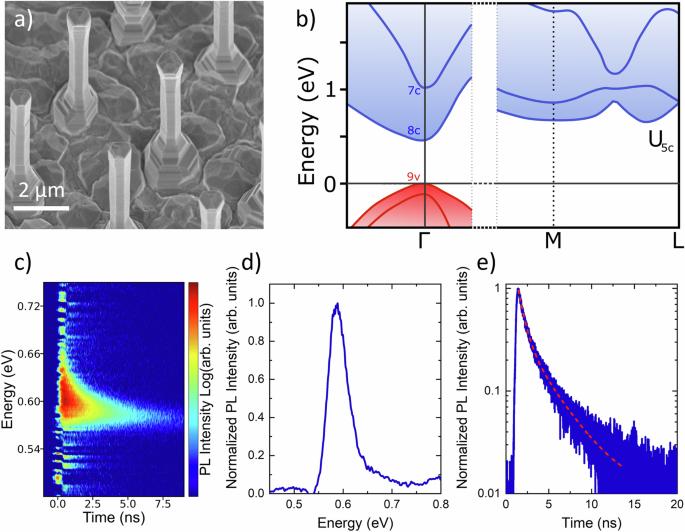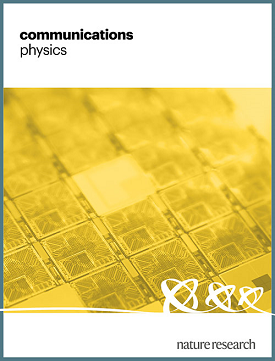六边形硅锗纳米线的受激发射
IF 5.4
1区 物理与天体物理
Q1 PHYSICS, MULTIDISCIPLINARY
引用次数: 0
摘要
六方晶相硅锗(hex-SiGe)具有 1.5 至 3.4 µm 的高效直接带隙发射。为了扩大其应用潜力,关键的挑战是证明六硅锗半导体激光器的材料增益。在此,我们报告了在六边形 Si0.2Ge0.8 纳米线的光学激发部分,自发辐射机制向受激发射为主的放大自发辐射机制的转变。我们观察到在自发辐射背景之上产生的窄共振峰,这些共振峰显示出激光特征,如阈值和发射的超线性增加。对空腔共振高度的哈基-保利分析提供了六硅锗的增益谱,显示了正材料增益的证据。对空腔线宽的测量提供了对空腔总损耗的独立评估。虽然还没有实现激光,但对光学放大和放大自发辐射的观测为六方硅锗实现激光提供了清晰的路线图。这为在电子芯片中单片集成硅兼容激光器开辟了一条新途径。六方硅锗具有高效的直接带隙光发射特性。在此,作者证明了六方硅锗中存在受激发射和光学增益,并提供了实现激光的路线图。本文章由计算机程序翻译,如有差异,请以英文原文为准。

Stimulated emission from hexagonal silicon-germanium nanowires
Hexagonal crystal phase silicon-germanium (hex-SiGe) features efficient direct bandgap emission between 1.5 and 3.4 µm. For expanding its application potential, the key challenge is to demonstrate material gain for enabling a hex-SiGe semiconductor laser. Here we report the transition from the spontaneous emission regime to the stimulated emission-dominated amplified spontaneous emission regime in the optically excited part of a hexagonal Si0.2Ge0.8 nanowire. We observe narrow resonance peaks arising above a spontaneous emission background, which show lasing signatures such as a threshold and a superlinear increase of the emission. A Hakki-Paoli analysis of the height of the cavity resonances provides the gain spectrum of hex-SiGe, showing evidence for a positive material gain. Measurements of the cavity line widths provide an independent assessment of the total cavity loss. While lasing has not been reached, the observation of optical amplification and amplified spontaneous emission provides a clear roadmap toward lasing in hexagonal SiGe. This opens a new pathway for the monolithic integration of a Si-compatible laser within electronic chips. Hexagonal silicon-germanium features efficient direct bandgap light emission. Here, the authors demonstrate the presence of stimulated emission and optical gain in hexagonal silicon germanium and provide a roadmap to reach lasing.
求助全文
通过发布文献求助,成功后即可免费获取论文全文。
去求助
来源期刊

Communications Physics
Physics and Astronomy-General Physics and Astronomy
CiteScore
8.40
自引率
3.60%
发文量
276
审稿时长
13 weeks
期刊介绍:
Communications Physics is an open access journal from Nature Research publishing high-quality research, reviews and commentary in all areas of the physical sciences. Research papers published by the journal represent significant advances bringing new insight to a specialized area of research in physics. We also aim to provide a community forum for issues of importance to all physicists, regardless of sub-discipline.
The scope of the journal covers all areas of experimental, applied, fundamental, and interdisciplinary physical sciences. Primary research published in Communications Physics includes novel experimental results, new techniques or computational methods that may influence the work of others in the sub-discipline. We also consider submissions from adjacent research fields where the central advance of the study is of interest to physicists, for example material sciences, physical chemistry and technologies.
 求助内容:
求助内容: 应助结果提醒方式:
应助结果提醒方式:


